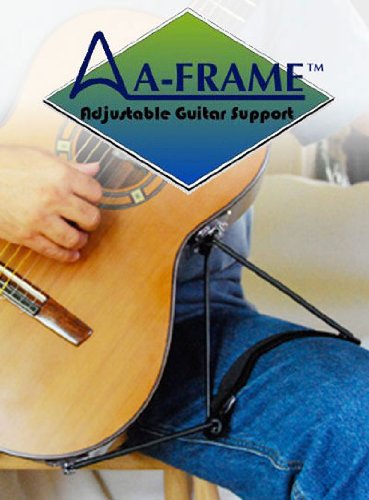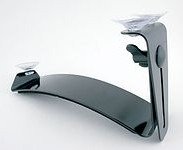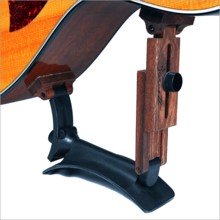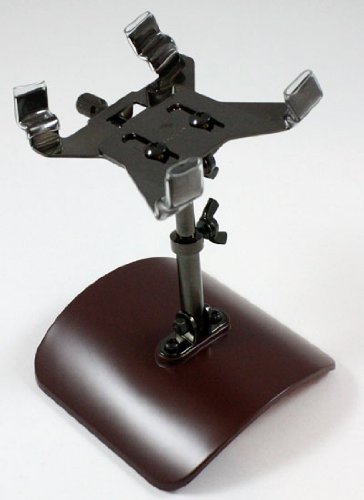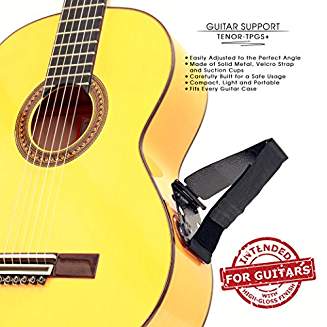Classical Guitar Supports
The page on classical guitar sitting positions tells you how classical guitar supports can help ease discomfort while playing the classical guitar. All the classical guitar supports discussed on this page help to keep the back straight and the hips level and all have different pros and cons that are shared.
I’m getting a lot of messages from people coming here because they want to learn to play guitar as part of worship. If this is you, you might want to join Aaron Anastasi’s programme. Aaron is a musician and a worship leader. He put together a step by step programme for aspiring Christian musicians. If you're interested, you can use the exercises and advice in learn-classical-guitar-today to develop your finger strength and dexterity and Aaron's lessons to work on strumming and worship music.
CLICK HERE TO LEARN WORSHIP GUITAR !!
There are really only three different designs that are used for classical guitar supports. All the products in the market fall into one of these three categories.
Design Type 1: The Trapeziums
The first design is what I call THE TRAPEZIUMS. These designs form part of (or all of) a trapezium or triangle. They rely on a combination of gravity and suction cups to create and maintain the attachment to the guitar.
The strength of these designs is that they have the potential to be pretty solid and to last for years and years. This very strength is also a weakness as it results in them being big, clunky and awkward to carry around. Another, and probably the biggest weakness, is that their predefined structure means that they don't suit all body shapes and sizes.
The four well known models in this design are:
- The A-Frame (click the A-frame to see below)
- The ErgoPlay (click the ErgoPlay to see below)
- Barnett Guitar Supports which is now called Sagework (click the Barnett Guitar Supports to see below)
- The Murata (click the Murata to see below)
The A-FRAME
The A-Frame Guitar Support is shaped as a triangle . The broadest part rests on the left leg and the tip of the triangle has a suction cup that attaches to the guitar.
It is designed to lift the guitar and to angle the guitar neck to aid in achieving the perfect height and angle for playing.
The biggest benefit of the A-Frame Guitar Support is that it allows adjustments to all 3 sides of the triangle which can then be locked in as your optimal playing position . The second benefit is that it can be collapsed and so easily transported and stored.
The biggest weakness is that the suction cups have a tendency to fall off. Also, the finish on a small number of guitars have reacted to the suction cups which left a mark on the guitar finish that would not wipe off.
Click to go to the detailed A-Frame review .
The ERGOPLAY
The ErgoPlay Guitar Support is a L-shape guitar support that is made of metal with a suctions cup on either end that attaches to the guitar. The longest part of the L-shape rests on the left leg.
The ErgoPlay Guitar Support is designed to raise the guitar and to angle the guitar for classical guitar playing.
The benefit of the ErgoPlay is that it allows for some adjustment to the playing angle and to the height. There are no reports of the ErgoPlay doing any damage to guitars, although because it is constructed of metal one has to be extra careful not to bang the guitar when attaching and detaching .
The main concern is that the range of adjustment that the ErgoPlay allows is insufficient for it to be setup for all body types and there are many reports of classical guitar players finding it just too high for comfort and reverting to their footstool.
Click to go to the detailed ErgoPlay review.
BARNETT GUITAR SUPPORTS (NOW CALLED SAGEWORK)
Barnett Guitar Supports (now called Sagework) comes in 4 different model sizes: the Atlas, Atlas Short, Umbra and Umbra short. The picture alongside is of the Atlas.
Barnett Guitar Supports are rated as one of the best guitar supports on the market. What sets the Barnett Guitar Supports apart from others in THE TRAPEZIUM category is that the Barnett uses magnets placed inside the guitar as the attachment device and the Barnett (now Sagework) attaches with a magnet to these fixed magnets.
The Barnett Guitar Supports are highly rated. The pros are the excellent craftmanship, the unique and very stable magnet attachment and the flexible height options that it allows.
The con is that it is not easy to buy. At the moment it is only available at Strings by Mail. As most guitar shops don't stock it, you will have to chance your luck with the model and size and then hope it fits. If it doesn't, there is the hassle of getting it back to Strings by Mail for an exchange.
The second, and probably bigger concern, is that it is very expensive. Strings by Mail is selling it for $120 which is hard to justify when there are guitar supports that are known to work well for way less than that. In fact, my recommended guitar support (see The Verdict lower down this page) is 20% of this price. It is particularly hard to justify when you might have the additional cost of double postal should you need to return it to get to the perfect size for your body.
A review that I can trust is available at www.thisisclassicalguitar.com. Click here to see the Barnet Guitar Support review.
THE MURATA GUITAR REST
The Murata is a Japanese product. The excellent engineering and high quality materials used reflects traditional Japanese craftmanship. It sits comfortably on the leg and allows the guitar to be raised anywhere between 45% to 65% depending on where you attach it.
The pro of the Murata is that it allows multiple heights which not many guitar supports do. It also swivels and holds very firmly and securely onto the guitar.
The con is that it is not easy to buy. Other than secondhand sellers on Ebay and Amazon only Strings by Mail sells it at the moment. At about $70 to $80 it is also not the cheapest guitar support available.
A review that I can trust is available at www.thisisclassicalguitar.com. You can click here to see thisisclassicalguitar.com's Murata Review. Another detailed review that can be trusted is provided by a at www.classicalguitardelcamp.com. Another is available in the chat room. Click here to read the www.classicalguitardelcamp.com's Murata Review.
Design Type 2: The Ledge
The second design is what I call THE LEDGE. These attach onto the guitar body (usually with suction cups) and form a ledge on which the guitar rests. These designs rely on different cup designs to keep them in place and their usability and rating is much dependent on the quality of the cups used.
The four well known models in this design category are:
- The Efel Guitar Rest (click the Efel Rest to see the details below)
- Gitano Classical Guitar Support (click the Gitano to see the details below)
- TENOR TPGS Ergonomic Guitar Rest (click the Tenor TPGS to see the details below)
- Flanger Guitar Support (click the Flanger to see the details below)
THE EFEL GUITAR SUPPORT
The Efel guitar support attaches to the base of the guitar with a large suction cup. It's made of a flexible plastic that contours to your leg. The support is 7 inches long and 3.5 inches wide.
Here's a video of Stepan Rak using the Efel Guitar Support to play Greensleeves.
I own and use the Efel almost daily and have done for the past decade. Other than the ErgoPlay, the Efel Classical Guitar Support is my favourite guitar support. The pros are that it is very stable and comfortable on the leg and easy to attach and detach. The con is that the little suction cup needs to be rinsed in warm soapy water every few months otherwise it built up dust and oils can make the suction less secure. This might be true for all the suction cup devices though.
Click to go to the detailed Efel Review.
GITANO CLASSICAL GUITAR SUPPORT
The Gitano is a llghtweight metal guitar support with 3 suction cups.
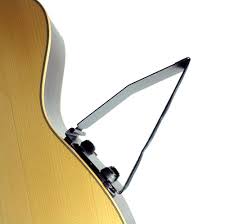
It's greatest advantage is that it brought to the market the for the first time a foldable LEDGE DESIGN guitar support that fits easily into guitar bags and could possibly in its folded position remain on the guitar if your guitar bag or case allows.
It's greatest con, however, is that there are reports of the Gitano damaging guitar surfaces. The Gitano is sold with a warning that asks owners of Shellack or Nitro finish guitars to NOT USE THE GITANO. The other concern is that owners of glossy guitars have been frustrated by the Gitano simply refusing to adhere. Others have reported the little metal rounded bit that sits on the leg cutting into their leg, especially if they are wearing shorts.
Notwithstanding these concerns, there are many who rate the Gitano very highly.
Here are three reviews of the Gitano:
TENOR TPGS ERGONOMIC GUITAR REST
The Tenor TPGS has a similar design to the Efel but is a more recent design.
I haven't bought one because I have the Efel but I spent a few days with one that I borrowed to do this review. I
The Tenor TPGS is the a new kid on the block and they have used that to their advantage by learning from the other guitar supports on the market, listening to the criticisms and complaints of guitarist and addressing these in the Tenor TPGS.
They 've managed to meet all the strengths of the Efel (the secure and solid lift and angle), the strength of the A-Frame (the flexible adjustments via velcro straps) and those of the Gitano (its compact portability and that it can fold-up). And they've done this by avoiding the pitfalls of the Gitano (not adhering securely and potentially damaging some guitars), the Efel (not being foldable), the A-Frame (not being secure on the guitar) and the ErgoPlay (not having enough range of adjustment in terms of height and angle).
I am so impressed by the Tenor TPGS that I've ordered one for myself.
The Tenor TPGS comes with a little peel-off plastic stickers to protect the guitar's finish. Having seen this little sticker in action on a friend's guitar, I'm now confident to use it even on my guitar which is the last guitar built by the master Valencian luthier Manuel Adelito.
If you skip down to the verdict section below, you will see that the Tenor TPGS is my strongest recommendation . It is also, interestingly, the cheapest of all the guitar supports covered in this page.
Click here for a more detailed review of the Tenor TPGS.
FLANGER GUITAR SUPPORT
The Flanger Guitar Support is lower than what is needed for classical guitar playing and is more suited to folk playing which really is what it was designed for. Please be warned that there are reports of the Flanger damaging the finish of guitars.Due to this I'm not recommending the Flanger for classical guitar playing.
Design Type 3: The Cushion
The third design is what I call THE CUSHION as these rest on the leg and the guitar rests on the shaped cushion. It is sometimes used with a footstool that it set on a low position to achieve the desired height and angle. The first one to be made was the Dynarette which was designed in the mid 1980s by George Varney. It was manufactured and distributed from Sweden. Since then, a number of other (mainly Chinese) manufacturers have copied the design.
Below is a list of the popular versions available in the market today. None of them deviate in any way from the original Dynaretre although the quality and workmanship is different. While the Dynarette is made of a PU leather, some of the cheaper version are more plasticy. There is also quite a difference in price. The large Dynarette is more than $45 while the cheaper Chinese copies sell for almost half this price.
- The Dynarette is a contoured cushion with a built in and shaped sponge that sits on thigh perfectly. Click to go to the Dynarette review below.
- YIFAN guitar pad
- Flanger FA-80S guitar cushion
The Dynarette Support Cushion
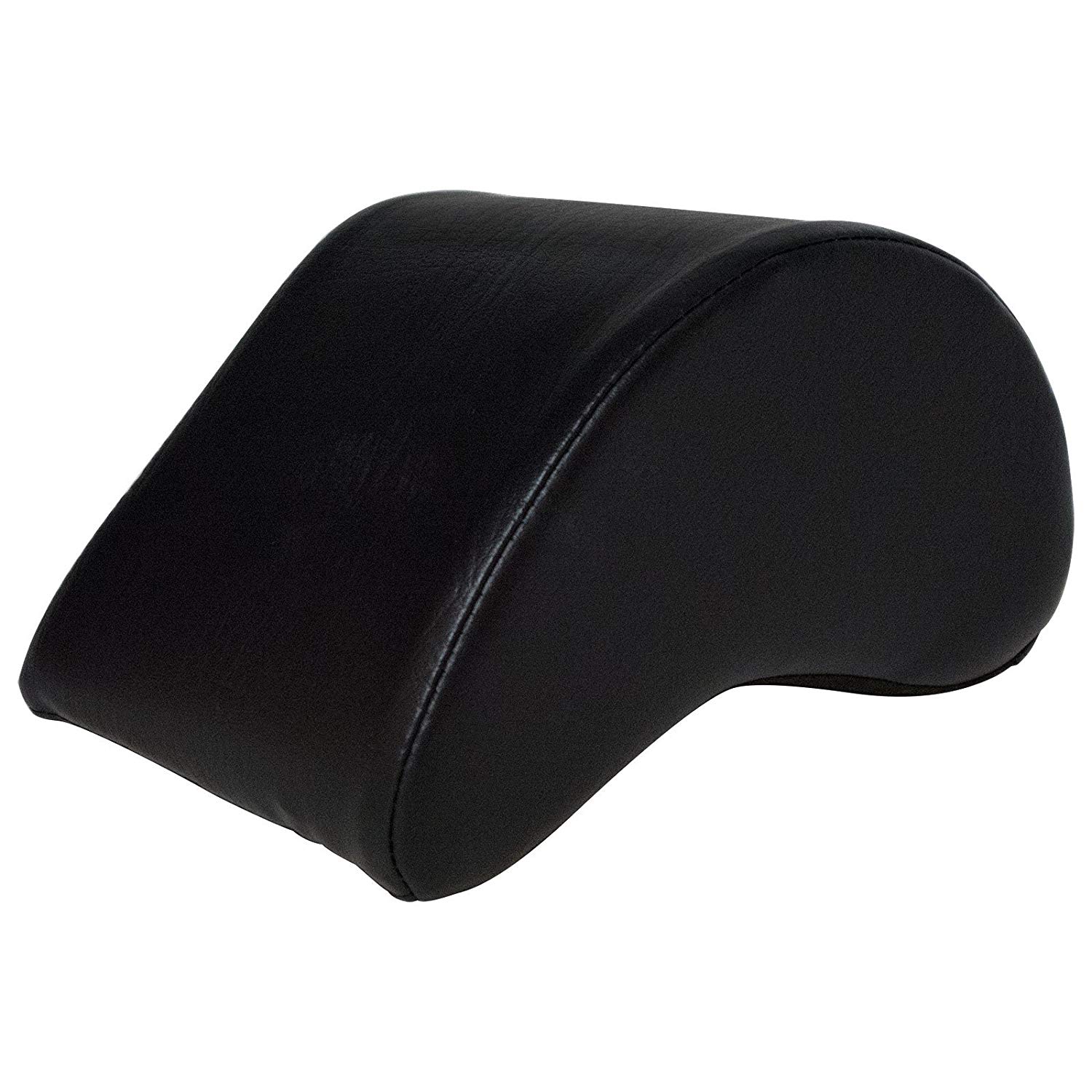
- The Dynarette is a contoured cushion with a built in and shaped sponge that sits on thigh perfectly. The Dynarette Guitar Cushion comes in two different sizes: small and large.
The benefit of the Dynarette is that it sets the neck up at a 45 degree angle and doesn’t use suction cups to do so. However, you can’t easily change the angle of the guitar. The guitar sits at 45% (about – as it depends on how tall you are and the size of the guitar body) and that really is that. There have also been complaints (especially with the cheaper brands) that the Dynarette (or copies thereof) can slip and slide from the leg. This is, however easily solved with a strip of grippy fabric to the leg.
Depending on your height, the Dynarette might not raise the guitar high enough. For some this is a problem, but others use a footstool on a low setting and find that this works well with the Dynarette.
Click x to see review
The Verdict
All three of the designs have various strengths and weaknesses.
- The structure of the TRAPEZIUM TYPE guitar supports makes them a solid choice, but they are more limiting in their range of height and angle options to the LEDGE TYPE guitar supports. The Barnett is a clear winner as it is an excellent guitar support. It is, however, at about $120 also very very (and I would argue unnecessarily) expensive for a beginner or intermediary guitarist. My recommendation in this category and the support that I use regularly is the Ergoplay Tappert which is less than half the price. You can click here for a more detailed review of the ErgoPlay Tappert.
- The LEDGE TYPE guitar supports face a different set of challenges. Mainly, the design challenge is lies in the suction cups that attach it to the guitar and the secureness of these. The benefit of the LEDGE TYPE is its compactness which is increased in the Gitano and Tenor TPGS which are also foldable. The clear winners in this category are the Tenor TPGS and the Efel guitar supports. The Tenor TPGS Guitar Support has all the benefits of the Efel, while adding to that the foldup benefits of the Gitano. Despite being the clear design winner, the Tenor TPGS is also one of the cheaper guitar supports available.
- The CUSHION TYPE guitar support is the most comfortable but is not necessarily high enough or angled enough to support all tastes. Guitarists who use the Dynarette or other cushion designs have corrected for this by using a foot stool at a low setting. If your desire is to get away from the footstool completely then the cushion design might not be the best way to go. However, many performers prefer the comfort and the fact that it hides on the lap and can be used with a low footstool. The most popular and clear winner is the Dynarette. Despite it's weaknesses, which are discussed in the Dynarette review below, the Dynarette Guitar Support has had the longest time in the market to improve on its design and to prove itself. None of the newer competitors have the company name of the Dynarette yet, but that certainly doesn't mean that you shouldn't give them a go ...
The overall winner is the Tenor TPGS. The Tenor TPGS has turned being the new kid on the block an advantage by meeting all the strengths of the Efel (the secure and solid lift and angle), the strength of the A-Frame (the flexible adjustments via velcro straps) and those of the Gitano (its compact portability and that it can fold-up).
And they've done this by avoiding the pitfalls of the Gitano (not adhering securely and potentially damaging some guitars), the Efel (not being foldable), the A-Frame (not being secure on the guitar) and the ErgoPlay (not having enough range of adjustment in terms of height and angle).
The A-Frame
The A-Frame Guitar Support is designed by Sageworks. The A-Frame was designed to adjust the angle of the guitar neck to aid in perfect positioning for playing. Highly recommended by Aaron Shearer. The A-Frame adjustable guitar support is simple to use, yet offers a greater variety of positioning than has ever been available for the guitarist. The ability to make adjustments to 3 separate aspects of positioning, and then lock them into your optimum playing position is a unique feature of the A-Frame. Basically there are three adjustments: Left or right adjustments, angle adjustment, and height adjustment.
Below is a video where David Stevenson does a demonstration of the A-Frame
The Pros and Cons
THE PROS
- It folds up and easily slips into a guitar case or bag
- Comes with a year warranty from the supplier
THE CONS
- It doesn't fit all sizes of guitar so be careful to take the measurements of your guitar. It particularly doesn't fit half size or 3/4 size instruments.
- The suction cups have a tendency to fall which can annoying and embarrassing if you're performing
- The finish on a small number of guitars may react with the suction cups on the a-Frame, and leave a mark on the finish that will not wipe off. The supplier states that most guitars won't have this problem, but offers a refund if you have this problem.
Best Review Comments (Amazon rating 3.9 out of 5)
- C. Finnigan (Klamath Falls, Oregon USA): My Guitar A-Frame Support is exactly what I needed for my Guitar! I can literally play sitting anywhere. I was and am amazed and delighted on how the A-Frame works and believe it is a necessity if you own a guitar.
- Seashells (Fort Walton Beach, FL): The A-Frame adjustable guitar support is simple to use, yet offers a greater variety of positioning than has ever been available for the guitarist.The ability to make adjustments to 3 separate aspects of positioning, and then lock them into your optimum playing position is a unique feature of the A-Frame. Basically there are three adjustments: Left or right adjustments, angle adjustment, and height adjustment. ***Note: The finish on a small number of guitars may react with the suction cups on the A-Frame, and leave a mark on the finish that will not wipe off. The vast majority of finishes have no adverse reaction to the suction cups. During the first few weeks of use, you should inspect the finish regularly and contact Sageworks if you notice a problem.
THE VERDICT: When the A-Frame was first designed over twenty years ago it took the guitar industry by storm. Classical guitarists were for the most part suspicious of it and didn't start using it until the early 2000s. Since then, and as you can see by all the guitar supports that I share with you on my page on guitar supports the guitar support industry has expanded since then and the classical guitar player has a lot more choice to select from.
The verdict is that the A-Frame Guitar Support started a revolution but hasn't really kept pace with it and now just isn't able bto face down the competition that has grown over the past twenty years. The A-Frame is a great concept, but at this stage probably needs more work.
Having said all this, I know classical guitar players who swear by their A-Frames and who love using it. At the end of the day, you really do need to try it out to see what best suits you.
The Dynarette
The Dynarette Guitar Support comes in two different sizes: small and large. The Dynarette is designed to replace the traditional footstool, allowing guitarists to sit more comfortably, and in proper balance while playing.
The Dynarette Guitar Support helps players maintaining a good posture while seated, reducing muscle stress and fatigue, therefore allowing more freedom of movement and enabling the musician to spend less energy holding the guitar, and more energy playing the guitar.
THE PROS
- Sets the neck up at a 45 degree angle
- Doesn’t use suction cups
- Inexpensive, especially when compared to other guitar supports
- Comes with a drawstring bag for carrying it around
THE CONS
- Not stable enough. Depending on the fabric of your pants or skirt, it could slide from the leg. This is easily solved with a strip of grippy fabric on the leg.
- The adhesive strip on the bottom becomes less adhesive overtime which accentuates the problem above.
- You can’t easily change the angle of the guitar. The guitar sits at 45% (about – as it depends on how tall you are and the size of the guitar body)
- The seller claims that the pad is made of leather, but it’s definitely made of a polyurethane substance.
- One size doesn’t fit all: For grown-up guitarists, the pad should be longer, with a less acute angle or slope, and the adhesive strap underneath, wider and greatly expanded.
- The zipper of the case has been known to come loose and to break
Review Comments (Amazon rating 4.2 out of 5)
- By Joshua Garrett (Berwyn, IL) : I've been playing guitar for over twenty years, but have only been playing classical seriously since last fall. The traditional recommended posture actually strained my back somewhat, so I started researching different guitar supports. After getting the Dynarette, I knew this was the best decision for my body, and also for my playing. After spending some time with it, I settled on a particular placement that facilitates more comfortable and focused playing. It allows me to have a more physical connection with my instrument, where I can hold more of the back of the guitar against my torso. I use the large Dynarette every time I play classical guitar, and I have found it to be a very ergonomic tool that takes pressure off your body and improves connectivity with your instrument. I recommend it highly.
- By The Iguana (LA, CA) : Love it! I used to use a guitar foot rest but that resulted in back pain after just 15 to 30 minutes of practice. I bought this cushion and put aside the foot rest. With the cushion, I can sit straight, keep both feet on the floor, keep my spine straight and still have my guitar in excellent position for flamenco and finger style playing. I bought the large size. It raises my guitar 5.5 inches. There is also a small size that will raise your instrument 3.5 inches. This is one guitar accessory that is well worth the cost.
THE VERDICT: The Dynarette Guitar Support works well for some, but not for others. The usability seems to depends on the size of the player. You will also have to be prepared to always use an additional cloth to help it stay stationary on the leg. You'll have to try and see if it works for you.
The ErgoPlay
The Ergoplay Guitar Support (Tappert) rest is designed to improve playing technique and optimize acoustics, by allowing you to maintain the correct posture whilst playing.
It is proven to be the safer alternative to a foot rest, by relieving stress on your spine and allowing you to breath more easily. The Ergoplay Guitar Support allows the player to maintain the correct posture for playing. The best way to achieve a straight spine and a healthy pelvic posture is to keep both feet on the floor. You will be able to breath more easily and practising and performing will be more fun. Holding the guitar correctly makes it easier to play with a correct technique. Play without getting tired and concentrate longer.
The concert guitarist benefits from Ergoplay since, with an upright posture they can practise or play concerts longer. A healthy ergonomic seated posture promotes concentration and, crucially, gives a better impression on stage. Ergoplay allows the guitar to be held in such a way as to allow the base to vibrate freely giving you noticeably more volume.
I have to start of this list of pros and cons by saying that I use the Ergoplay Tappert myself. I have two supports that I use: the Ergoplay Tappert and the Efel. The Efel I tend to use if I'm slouching on the couch and the Tappert when in a more formal practice or performance context.
PROS
- The ErgoPlay allows for some adjustment of the cups which allows for some adjustment to the angle
- Can be fixed securely without leaving marks
- A large clamping screw combined with a range of placements of the suction cup allows for easy adjustment
- The suction cups are easily replaced
- Sits comfortably and securely on the leg
- Very well made and will last for years and years
CONS
- Complaints that the suction cups are annoying. I have, however, never found them to be a problem. A little bit of water on the finger rubbed into the suction cups have served to completely secure the cups to my guitar.
- It is made of metal which makes it solid and long lasting, but also means that you have to be careful not to bang your guitar when attaching or detaching.
- Doesn’t work well for lefty guitarists as the angle of the bottom cup favours right handed players.
- Some players have not been able to get comfortable with it and have reverted to their footstool.
- The above concern is mainly because the range of adjustment that the Ergoplay allows is not sufficient for everyone and some have complained that they were not able to get a comfortable position with it.
- It doesn't fold up and therefore will not fit into either a guitar case or guitar bag. It has to be carried in a separate bag.
Ergoplay Review Comments (Amazon rating 4.5 out of 5)
Tim in VA: I think I've tried just about every accessory out there for raising a guitar to a proper and comfortable playing position, and this one so far is the clear winner. Construction is lightweight and seems rugged enough. Adjustments are simple once you get the idea of how the thing works and have the suction cups properly set up for your guitar.
Hooked On Classics: I waited to write this review pending my evaluation. I am very impressed with this product for the following reasons: 1. Solid well thought out design and construction 2. Easy to attach and adjust 3. Cosmetically nice 4. Positions hands in proper location for ease of play. One suggestion I have is to make sure that once the correct position is located to make sure the adjustment screw is securely tightened. This will prevent any potential chance of the metal bracket slipping and coming in contact with the guitar surface. I recommend this product for any serious minded classical guitar user. You will not be disappointed. Thank you ErgoPlay for a great product!
Neal B: If you play a classical guitar, you should definitely own one of these! For under $60, it's a must-have accessory. My back feels much better using this unit and I find myself sitting with better posture and playing more. It's much lighter than it looks yet feels like a quality product. It quickly attaches and is quickly removed. I also don't have to worry about scratching the underside of the guitar with cargo short buttons or anything in my pocket when using this. The only complaint I have is that it won't fit into a guitar case's center storage. I'd like to see them make one with a hinge so it could be folded down to nearly flat. Regardless, this is a 5-star product.
THE VERDICT: The Ergoplay Guitar Support of the best guitar supports on the market. Its suitability for you will depend partly on the angle of the guitar that you prefer and on whether you are prepared to moisten the cups slightly (very slightly) prior to using it.
The Efel
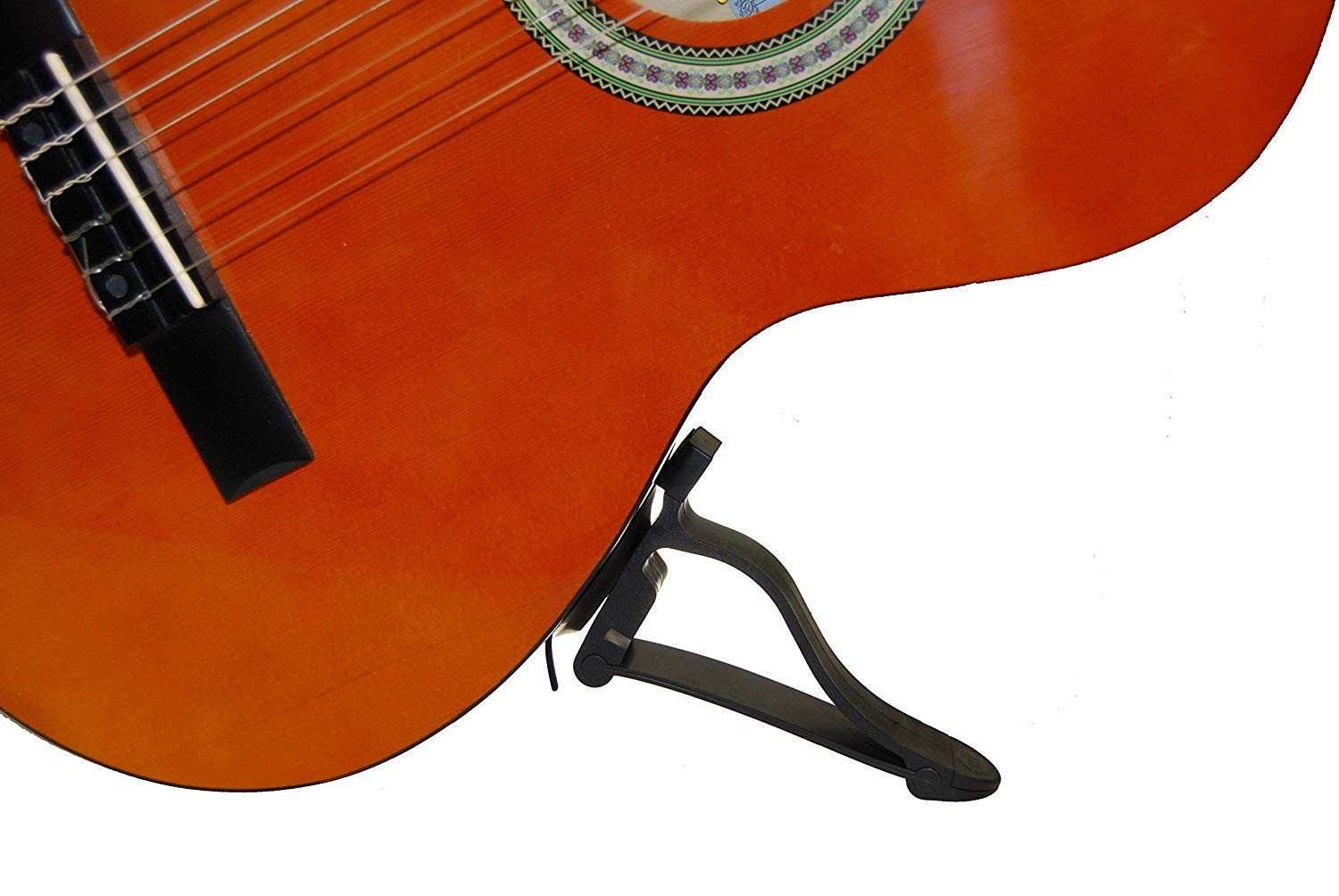
A guitar support that lifts the guitar approximately 30 to 50% degrees (depending on where along the rib it is attached). The EFEL ADVANCED attaches to the base of the instrument with 1 large suction cup. It is made of a flexible plastic which contours to your leg. The ADVANCED model includes 1 extension part which centers the guitar more evenly than other guitar supports. (You can purchase additional extension parts to provide more angle options if desired). An optional belt is provided which attaches to the bottom of the guitar. A strap peg is not necessary, the EFEL ADVANCED comes with a small plastic button that attaches with permanent adhesive. The belt is designed to apply reverse pressure to the support creating a balanced surface for the suction cups.
The Efel advanced is exactly the same as the basic option except that it includes a black strap that wraps around and under the leg and secures the Efel still further. Personally I found the black strap on the Efel Advanced a bit irritating to use as it took a while to get seated and to then get the Efel strap wrapped into the right position and secured under the leg. It also made the Efel Guitar Support that much more bulky. So the Efel Basic is used almost daily while the support strap for the Efel Advanced lies discarded at the bottom of a drawer. If my own experience is anything to go by, the Efel Basic (without the added strap) is the model that makes the most sense.
I own and use the Efel. Other than the ErgoPlay, the Efel Classical Guitar Support is my favourite guitar support. Here are the pros and cons as I've experienced it.
PROS
- It's very stable and comfortable on the leg.
- It's very quick to attach
- It's small and easy to transport
- It doesn't have any hard metal bits that can damage the guitar
- The player can choose the placement of it which then changes the angle and degree of tilt of the guitar. This makes it a good choice for players who are not comfortable with hte ErgoPlay.
CONS
- It slips sometimes. This happens very seldom but too often for me to feel comfortable using it other than for private practice. This is easily solved though with a small piece of adhesive plastic that you can get from the Efel company which you then stick directly onto the guitar. The plastic does no damage to the guitar's body but firms up the grip of the Efel.
- Replacing the suction cup, which doesn't need to happen more than once a decade, is an expensive business though as it costs almost half the price of a new Efel Guitar Support.
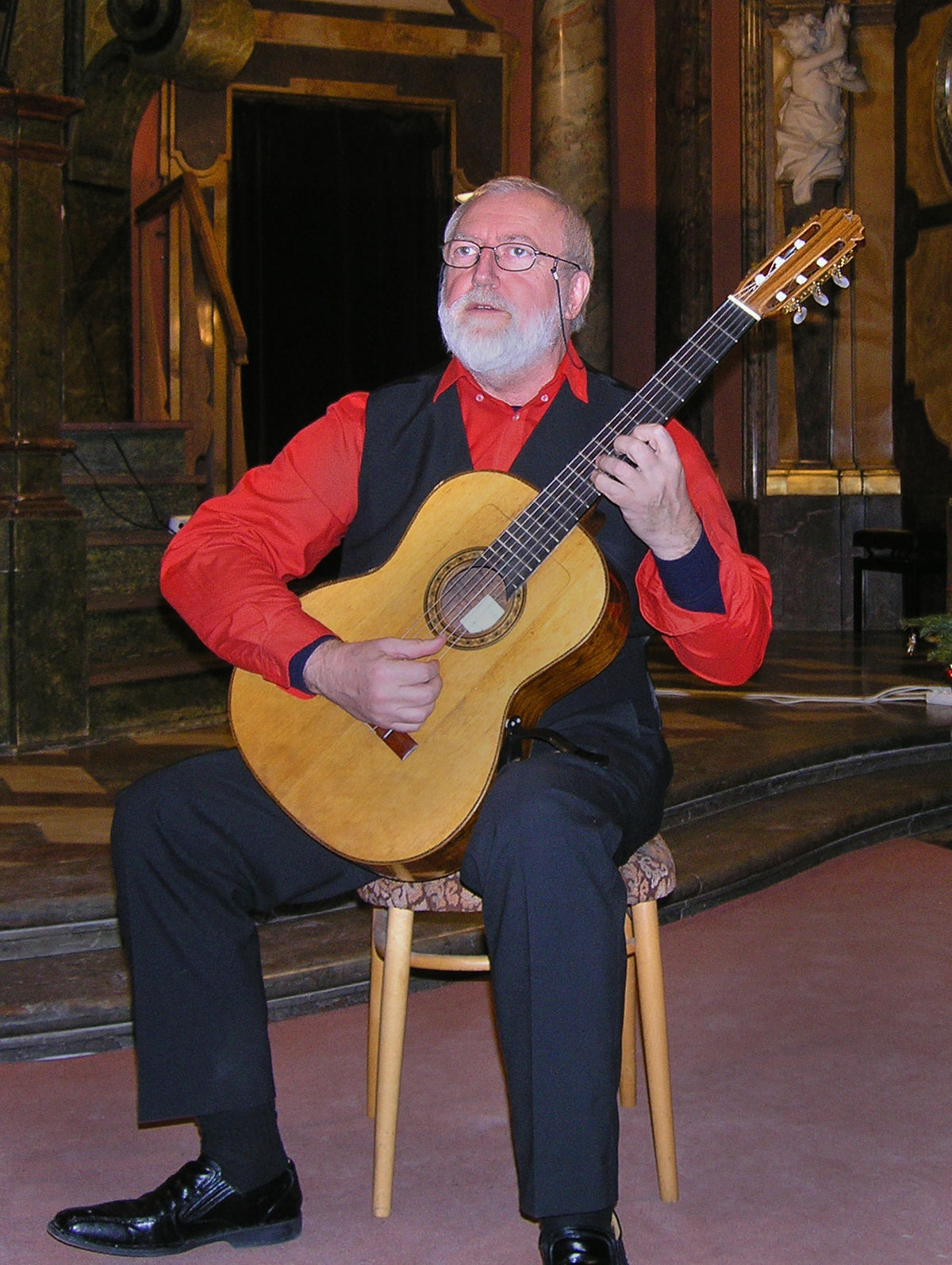
REVIEWS
There are no other customer reviews on the internet which is unfortunate as this is an excellent piece of kit that has been around for more than a decade now. The Efel Classical Guitar Support is the guitar support used by Stepan Rak in practice and in public performance. See this pic of Stepan Rak with his Efel Guitar Support.
The Gitano

Lightweight guitar rest for the classical guitar . The metal rest has 3 suction cups, and anti-slip textile stripFoldableFits in every guitar case (for transport).
PROS
- The Gitano Guitar Support is very loved for being compact and portable and fitting easily into most storage case pockets.
- The Gitano also has a fold up option which allows it to collapse (or foldup) on the guitar itself. This makes it very low profile and, depending on the size of your case, you might be able to leave it on the guitar when you pack it away (although this is not recommended).
- This support is versatile, working equally well for left- and right-handed guitarists and on both classical and acoustic guitars. It reduces stress on the lower back by helping to maintain a good playing position.
- The support's versatility extends to the guitar angles that it makes possible, from steep to almost parallel to the ground. Where you attach the two suction cups to the guitar determines the instrument’s angle.
- At the common medium angle, the support provides a lift range of about 2.75 inches to 3.5 inches. Like your guitar nearly flat? The support offers a lift range of about 1 1/8 inches to 1 7/8 inches. Like your guitar steep? The amount of lift increases as the angle increases, reaching a maximum of about 7.25 inches.
- Where the Gitano really shines is on the right leg in a flamenco position.
CONS
- Strings by mail recommend that the Gitano only be used for high gloss guitar finishes. It is NOT suitable for guitars with a shellac, satin, or French polish finish, or for expensive guitars.
- Notwithstanding the recommendation that the Gitano only be used on high gloss guitar finishes, there are many reports of the Gitano simply not adhering.
- Concerns that it slides and that the suction cup comes loose frequently and at times snaps out of there holders.
- The Gitano has been around for a long time, but seems to have changed their manufacturer recently as users have been complaining about shoddy workmanship.
The verdict: The Gitano Guitar Support is a solid option but it is not suitable for some guitar finishes. Specifically, it cannot be used for guitars with a Nitro or Schellack finish. I found the Efel to be much more comfortable and Efel was and also more secure. The Gitano can't be dismissed though as Andrew York has chosen it as the guitar support that he uses and endorses.

You'll need to go a little deeper into music theory as you proceed. The best online resource for this is Guitar Theory Revolution. It recognises that music theory is very hard for guitarists because music theory has till now been located in the piano paradigm. The Guitar Theory Revolution overthrows the piano paradigm that is holding you back and embraces the attributes of the guitar to unpack music theory. In fact, it goes further and allows you to see that the guitar is one of the best instruments for learning theory.
